Table of contents
- XXL Challenge Poland, 1st part Birthday purchases for 1000 euros
- The flyover: On the Road
- The problems: dying in installments
- The place of foundation: We are back!
- WSK 125
- Pannonia 250
- Jawa 350
- Info
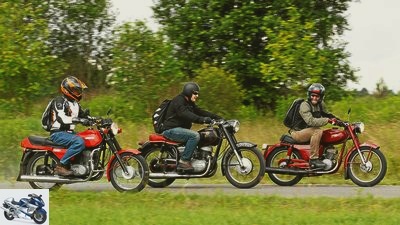
Bilski
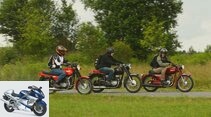

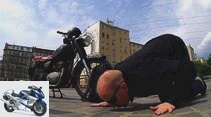
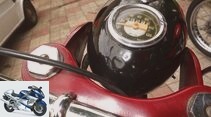
44 pictures
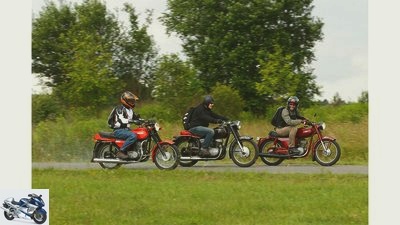
Bilski
1/44
Three men, three vehicles, an ultra-tough fight. The start: in Wroclaw, where it all began in 1903. The goal: to Stuttgart on its own axis.
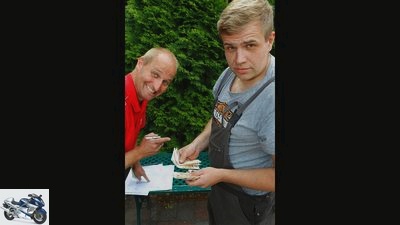
Bilski
2/44
Each bike was allowed to cost a maximum of 1000 euros.
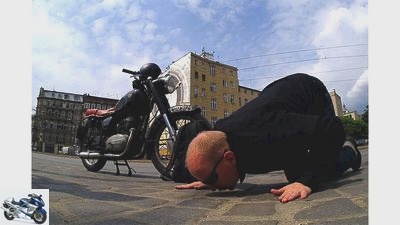
Lohse
3/44
Urges: incredible body control in the middle of a big city. why? The first issue of MOTORRAD was published here.
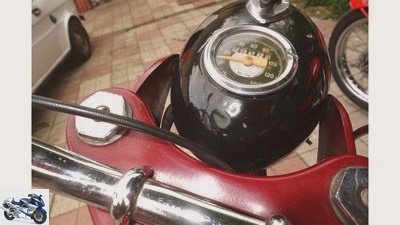
Breakable
4/44
At a mileage of 24,500, they parted ways.
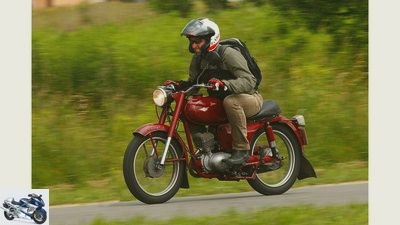
Bilski
5/44
Jorg Lohse on his WSK 125.
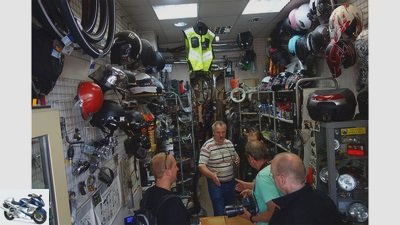
Breakable
6/44
Attention: Please only buy WSK spare parts if you still have a WSK.
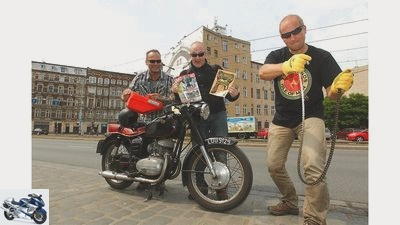
Bilski
7/44
Where it all began: MOTORRAD started at Matthiasstrabe 29 in 1903. In 2015 only the Pannonia starts here.
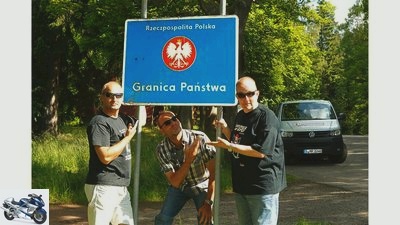
Bilski
8/44
All in all, a good balance sheet: We did not enter the country with any motorcycle, we leave with two motorcycles. In between we had three…
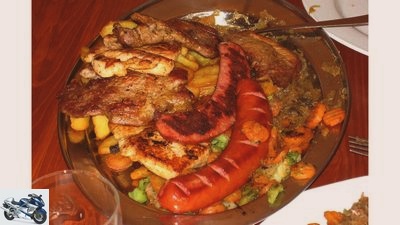
Herder
9/44
What can comfort the other two editors? Maybe the typical Polish light vegetarian cuisine for on the go.
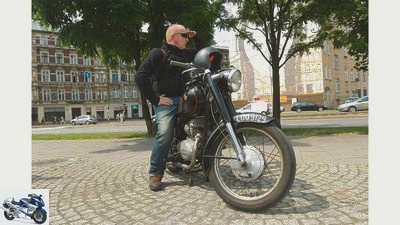
Bilski
10/44
Herder and his Pannonia are now all alone.

Lohse
11/44
Yeah what’s going on here? 70 kilometers from Breslau, Biebricher’s alternator refuses to supply electricity.
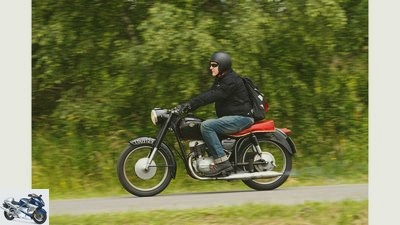
Bilski
12/44
Klaus Herder on his Pannonia.
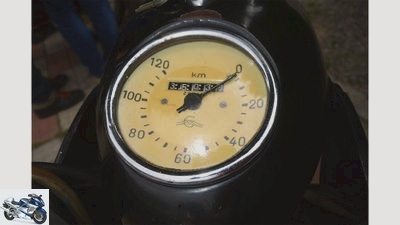
Breakable
13/44
The 120 km / h are quite realistic. So with a tailwind…
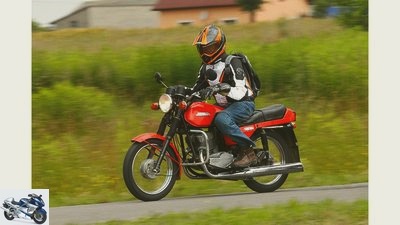
Bilski
14/44
Markus Biebricher on his Jawa 350.
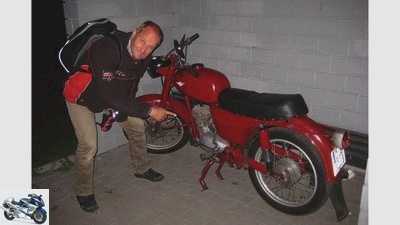
Bilski
15/44
And should you stumble across our value chain: We would be grateful for any relevant information.
Data: Type WSK M06 / B3, color red, year of construction 1971, VIN 1160478, license plate DJE 10UE (Poland).
Last seen in Siechnice on the road 94 (ten kilometers from Wroclaw) from June 29th to 30th, 2015.
Fame and honor await the finder as well as a complete set of biker equipment from the editorial pool!
Relevant information to wsk125@motorradonline.de.
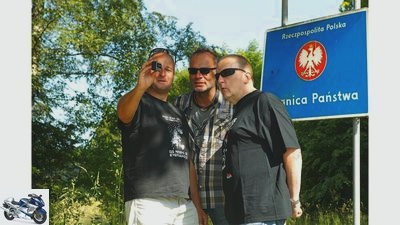
Bilski
16/44
Finally, it remains to refer to the road movie. You can find it on the last page of the article.
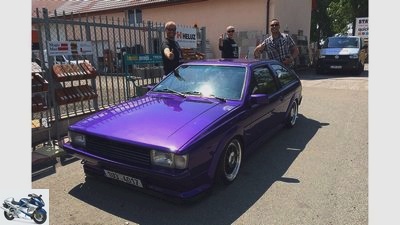
Bilski
17/44
Tempting offer: lowered Scirocco against Pannonia? “Never!”, Klaus Herder decides.
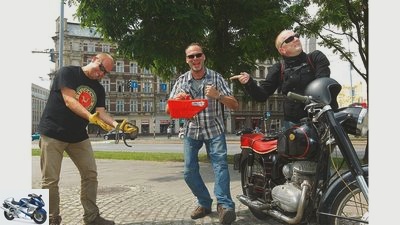
Bilski
18/44
Ultimately, only the chain was left of the WSK, the Jawa is missing a working alternator. The Pannonia is stuck, but still works to a certain extent.
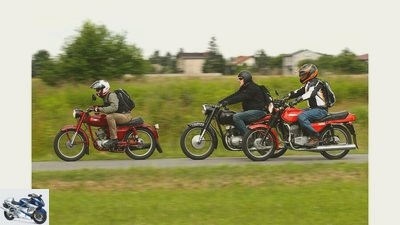
Bilski
19/44
But it was fun for everyone. As long as the motorcycles were running.
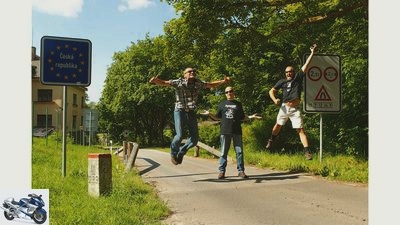
Bilski
20/44
The oldest and the oldest should win the challenge.
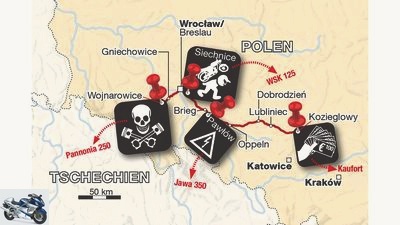
MOTORCYCLE
21/44
A small balance
Travel time: 2 days
Distance: 280, feels like 1000 kilometers
Working motorcycles: roughly one.
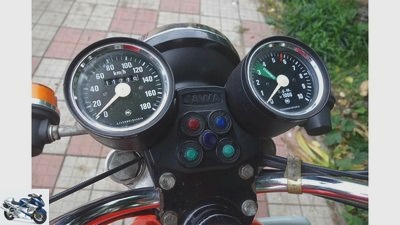
Breakable
22/44
The red indicator light works really perfectly.
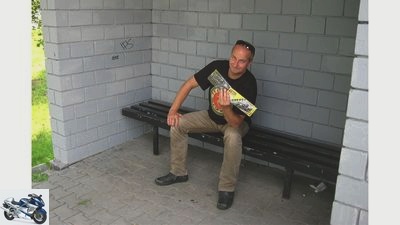
Herder
23/44
Really stupid: Lohse has a new value chain chain, but no value chain.
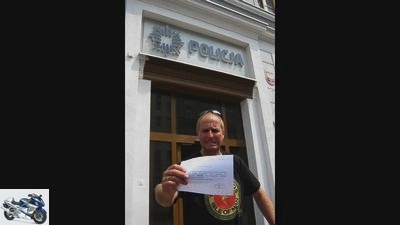
Herder
24/44
Only 120 minutes, second part: our interpreter translates from Polish to Polish in the Wroclaw police station.
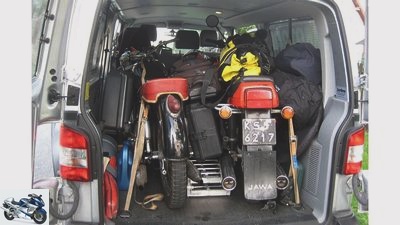
Herder
25/44
Maxed out: The journey home is a little different than planned.
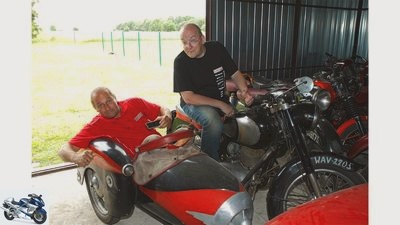
Bilski
26/44
Would this bike have done better? One does not know.
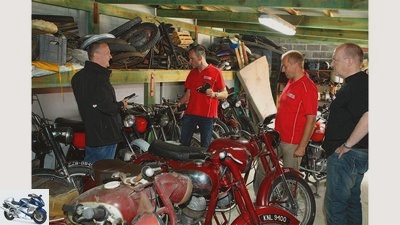
Bilski
27/44
A maximum of a thousand euros – what our editors choose?
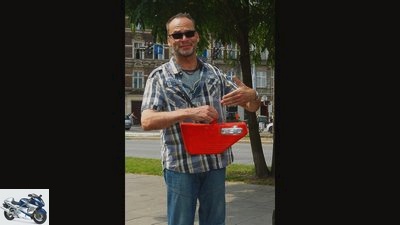
Bilski
28/44
Markus Biebricher – swears by the powerful two-cylinder Jawa.
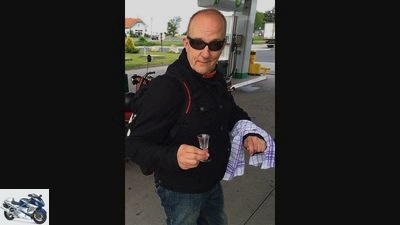
Lohse
29/44
Klaus Herder – Senior finds girlfriend of the same age. Her name: Pannonia.
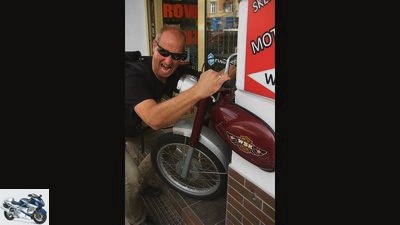
Herder
30/44
Jorg Lohse – the head of service testing makes himself very small for his value chain.
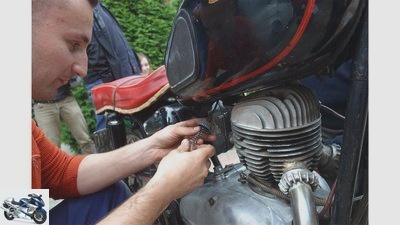
Breakable
31/44
Never a problemu: Slight rework on the Pannonia.

Lohse
32/44
Only 120 minutes, first part: Gregor and Norbert get the ladies ready to go. Theoretically.

Breakable
33/44
What can it be, stranger? The challenge participants were won over by the large number of oldies on offer.
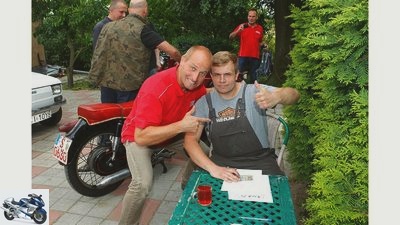
Bilski
34/44
Everything is in order: Jorg (left) and oldie dealer Rafael warmly greet the accounting department of Motorpresse Stuttgart GmbH & Co. KG.
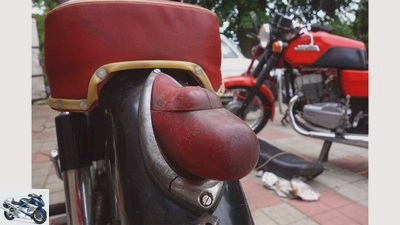
Breakable
35/44
Pannonia rear light: not a typical Bauhaus style, but nice.
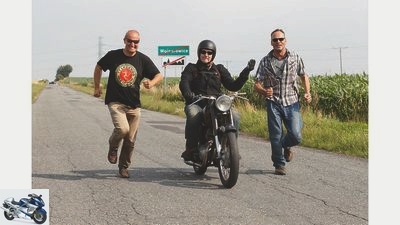
Bilski
36/44
One is running, two are running: The Pannonia is stuck, but is still alive.
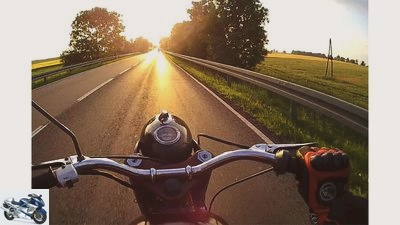
Lohse
37/44
… should only one traverse the routes of southern Poland.
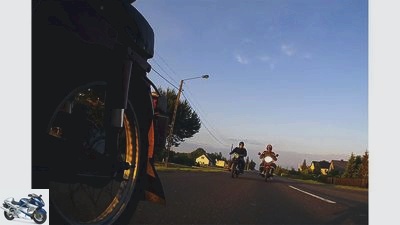
Lohse
38/44
The proof: All three machines run under their own power – madness! Shortly thereafter …

Bilski
39/44
The wiser one tips over: two short bottles per liter of fuel end up in the tank, which then corresponds to a mixing ratio of 1:25.
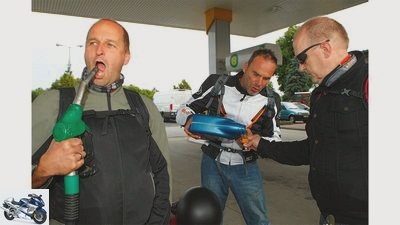
Bilski
40/44
It takes time: while Biebricher and Herder are dosing the oil, Lohse reaches for the pistol.
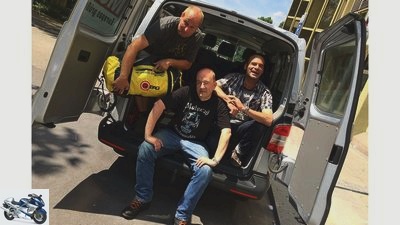
Lohse
41/44
The before picture. Later, the space had to be used for the maladen motorcycles…
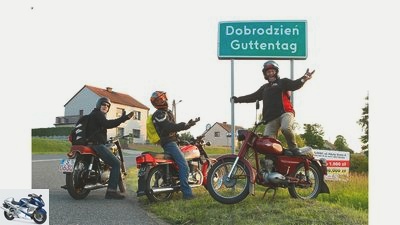
Bilski
42/44
Hello! In the beginning, all three bikes worked – more or less.
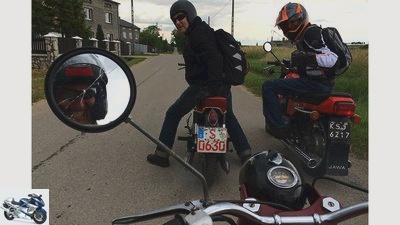
Lohse
43/44
Small flaws can be seen, but that doesn’t matter. It starts. At the start of the actual challenge…
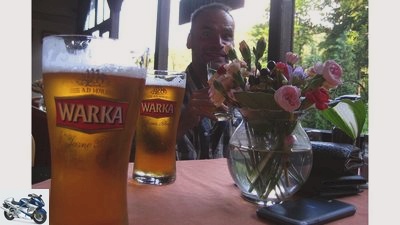
Herder
44/44
Sensations: aggressive beer drinking in the immediate vicinity of the border is also part of it. Especially when the challenge goes the way it should…
to travel
Life: XXL Challenge Poland
XXL Challenge Poland, 1st part
Birthday purchases for 1000 euros
The first issue of MOTORRAD back then “The motorcycle”, appeared in Breslau in 1903. A delegation from the current editorial team traveled there for the 112th birthday – with the following plan: Buy any two-wheelers from the East for a maximum of 1000 euros and take them back to Stuttgart. Three ultra tough men, one ultra tough fight.
Jorg Lohse, Markus Biebricher, Klaus Herder
08/03/2015
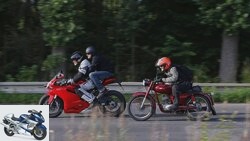
to travel
From Wroclaw to Stuttgart with Eastern Bloc classics
XXL Challenge Poland, part 2
read more
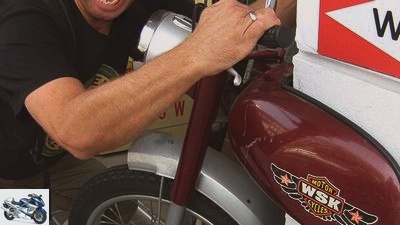
Herder
The head of service testing makes himself very small
Jorg Lohse: First of all, let’s ask ourselves, why do we have to go to Poland of all places to buy motorcycles? After 900 boring kilometers in the editorial van suddenly nobody wants to be anymore. I still know very well that it was Mr. Herder: “Artificial hips are supposed to be available here at an extremely affordable rate. Mopeds, too, guaranteed …” And the Biebricher got on right away: “Exactly, people like to go here to have their hair nice. For Kostnix!”
Buy complete article
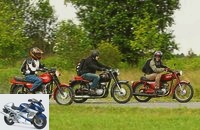
XXL-Challenge Poland, 1st part
Birthday purchases for 1000 euros
16 pages) as PDF
€ 2.00
Buy now
It slowly dawns on me that the old people have a completely different interest in this Polska Touristika event. Especially since they suddenly become very meek the closer we get to the destination address: This is definitely just junk. The parts have been standing since the fall of the Wall. That won’t work. Aha! I can already see that the old sacks will pinch and sink their budget into artificial joints and beautiful hair. Of course, both are difficult over 50.
I don’t care what is turned on to us. The main thing is to get out of this mess box. I like Rafael, whom Jacek found from our Polish sister magazine MOTORCYKL. Who presents the motorized Eastern Bloc in his barn with a thieving grin. When I squint at the 125 WSK, he winks. Aha, understand, house brand! With that they went down to Lake Balaton back then. Stuttgart, I’m coming!
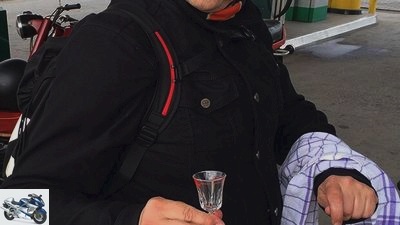
Lohse
Senior finds girlfriend of the same age
Klaus Herder: The Polish scrap iron dealer could have put up a Romanian hospital elevator for me. I would have bought too. Mainly built in 1962, this year only quality goods were built. Apart from the annoying Tom Cruise.
In contrast to the youngsters Lohse and Biebricher, Pannonia also tells me something: no recycled DKW core scrap from Poland and no overstrained two-cylinder (! -) Czech stuff, but solid craftsmanship from Hungary, which is permanently underestimated in this country. Plus the sharpest taillight by far that has ever graced a motorcycle – you just have to hit it!
Of course, the beautiful 250cc is the oldest Zossen in this challenge. But after all, I am also the oldest driver and have already driven two octaves in the east zone when Messrs Lohse and Biebricher were still running after the brass band in shorts.
Admittedly, the two hours we gave Rafael and his boys to turn grandfather clocks into functional 1000-kilometer racers are extremely tight, but if the basis is right, the drive home will also work.
However, I did not expect that MOTORCYKL editor-in-chief Jacek would use the wording “near Wroclaw” A shopping location a good 250 kilometers away meant that gave us a “Race before the race” bestows. Regardless, against the sad eight-liter small saffle and the high-end 350s clumped together with low-end means, I’ll mercilessly execute with the Pannonia (Again, colleagues: It’s called PANNONIA and not Paranoia!) My motto: old, fat – but fast!
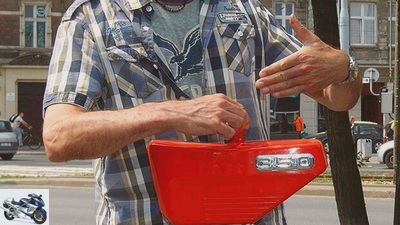
Bilski
Swears by the powerful two-cylinder Jawa
Markus Biebricher: When we board Rafael’s hall with the contrasting range of communist crackers, I realize that I need a two-cylinder. Preferably a 350 Jawa, which is considered an indestructible torque bull. Fortunately, our dealer still has a slightly patinated copy from the legendary 1984 vintage! I’ll use it to canned my colleagues.
Why Herder has to have this exotic Hungarian pannonia becomes clear to me when I look at the rear light. Such parts are not even available in the sex shop. I know that the colleague is crazy, but here he is submitting his sportsmanship to a bland fetish. The Hungaro cucumber was built in 1962 and has been standing for at least 30 years. It will finally die in the yard.
And Lohse with his Polish 125cc WSK? Do you think that it will bring him advantages if he is left with the lame heap of junk in Poland? Because every gas-water-shit-plumber can provide breakdown assistance here? Or he can lift his light egg file by hand onto a team of horses if the ailing single-cylinder cannot climb the mountains?
I never would have thought that my colleagues would be so naive if they were already getting involved in such an epoch-making competition. The Jawa will win! With performance, reliability and long-distance ergonomics. The steering head bearing that clicks into place in the middle and the slipping clutch? It’s all a question of driving technique. Eat my two-stroke flag, colleagues!
The flyover: On the Road
Jorg Lohse: Wonderful how easy life is. My WSK starts right away in front of Rafael’s barn and hops like a freed bunny over the paved dirt roads in the outback between Katowice and Wroclaw. Even with the throttle at three-quarters, I can keep the old men at a distance.
What is the Herder doing there? Can’t get it done with your foot and have to shift the gears of his 62 Pannonia by hand. Perhaps it would have been better to treat yourself to an artificial joint. The Biebricher is clearly overwhelmed with the performance of his Jawa. The Czech rocket probably still has the original tires from 1984 on it. Hard rubber, no grip. If the twenty-couple of horsepower really grabbed hold of it, Bibi is guaranteed to be cross. And then it was nice with hair. Anyway, the drama is behind me. A brilliant panorama in front of me. Off to the west, always towards the evening sun.
First get some fresh fuel. The colleagues bob up after me. Now just be careful that the two-stroke chairman Herder doesn’t get into trouble when calculating the mixing ratio. Not that he kicks his opponents out of the running with a lean mix. Okay, seems right. Oops, now the WSK is marching twice as well. If there was still a bit of the chassis left, I would have had my second after-work beer before my colleagues arrive in Wroclaw.
Hey what’s that My speedometer spontaneously decides not to show any more speed. Do I have to worry??
Klaus Herder: Of course, 800 meters is not really a long distance if you still have around 800 kilometers to go. But how could the good Rafael have noticed that the clutch was not engaging and the throttle was not accelerating? Even! So command back and invest another two hours in reviving Pannonia. The early evening is the better time to start anyway.
Two-stroke connoisseurs know: the colder, the more power. And so my beautiful Hungarian runs really lively on the second attempt. After the petrol-oil mixture, which had been stale for at least 20 years, has turned into delightful clouds of fog and the tank is filled with new fuel including racing oil, the old lady really shows what she can do: a surprising amount of pressure from the depths of the engine speed cell. The treasure only has one cylinder, but two mufflers, from which it exudes wonderfully robust. The sad Plangplangplang of the WSK (“Dachshund ships against metal buckets”) and the listless clanging of the Jawa offends the connoisseur’s ear, but the pannonia sound is really terrific.
In order to be able to enjoy it even more, I regularly lower my upper body to motor level. However, my colleagues falsely claim that I only do this to engage the gears directly by hand on the foot shift lever. Nonsense! Of course, Rafael and the like adjusted the clutch perfectly, and on the first 800 meters I had no reason to complain at the second attempt. But what lasts forever?
Markus Biebricher: Just awesome to be on tour again. Even if the departure was delayed because Herder did not have his technique under control. Now everything is good, and the stately two-cylinder engine of my Jawa sounds confidently like eternal servitude. The blue two-stroke flag in the rearview mirror marks a nice contrast to the red poppy fields, and the people along the way are happy that the motorcycles of their youth still have something to report in the Polish traffic. My Jawa shows long-distance qualities.
I enjoy the comfort of the chassis, even if the suspension elements have little use for unpaved village streets. The Czech racing car proves again and again how much flavor there can be in a lack: because the clutch barely disengages, every gear change is a challenge. Every curve anyway, because the handlebars click into place in the middle position. I am generously letting my colleagues overtake them, it will be good for their psyche. I can put them in their place again at any time.
When I’ve had enough mixture, I want to enforce, but the Jawa only turns up slowly. Why is this Pannonia so fast with its dog testicle taillight? Even the clumsy WSK can only be packed uphill. Did the others dop when they refueled? There, Herder has massive shifting problems, Lohse’s spark plug connector is marauding, now it’s time!
The problems: dying in installments
Jorg Lohse: Another 70 kilometers to Wroclaw. It seems to me as if I have already spent weeks at the WSK. In fact, we only left four hours ago. The sun is gone and our Eastern Bloc milling machines are really no longer real lights. Herder can score with the hottest rear light of all time, but the front of the Pannonia makes a dark room. I might not care, but it’s better to keep the old fox at a distance in the rearview mirror. Not that he launched a surprise attack under cover of darkness.
I am generous and give Herder and his frivolous lady an LED power projector. What is that now? Does the Biebricher switch to dimmer operation on the Jawa too? Or is the Lima fucked up? There is nothing left to save on the country road, take it to the Bulli. Penalty points for Bibi. Ha, he won’t take them out anymore! Although he’s something of “Swap controllers, and tomorrow it will work again” babbles. Sniffed too much two-touch mist, the man. Already clear why Rafael hung the Jawa’s battery on the fast charger before leaving.
Did I mention my kitten is still purring? Tomorrow I’ll put the battle name Duracell on her tank. What is that? The guy in the E-Class has probably filled up too much Piwo and can’t find the accelerator. So chapel and over. The boost is too much for the chain. But there was a beautiful constellation of stars on this godforsaken country road, my colleagues say later. I say a chain can be mounted on the WSK faster than a Lima can be installed on the Jawa, and stay calm. Until the next morning I have a new chain, but no longer a value chain.
Klaus Herder: Maybe my Pannonia is a chopper. We remember: “To chop” stands for “chop”, so throw away everything superfluous. Seen in this way, the speedometer, taillight, headlights, spark plug sockets and two out of four gears are pretty superfluous stuff that you can get rid of in that same order. At night, which is not really that dramatic, at least when it comes to the speedometer.
I don’t actually need Lohse’s LED floodlights. Until he had formally forced the part on me (“Road safety, you know …”), I was constantly in its wind / two-stroke vane shadow even without lighting. In the third of four gears at what feels like half the nominal speed.
A lot more would have been possible, but I preferred to let the little one go first. My boss doesn’t have to cry into the pillow of the hotel bed on the first Challenge evening. But my politeness was probably a mistake, because he had to start overtaking the drunk Daimler driver and catapult the WSK chain into the afterlife at a brutal 80 km / h. It was practical that a bus stop provided shelter for the wrecked Polish plane.
And let’s see it positively: At least the bus stop was still in place the next morning. Before I forget: what does colleague Biebricher actually do? Oh yes, the Lord is not so with Central European travel countries. It can get a little cooler there at night. Clever, if the controller dies at the right time …
Markus Biebricher: I am still convinced that the robust technology of the Jawa will ensure victory. Okay, as far as the sheer power of the two-cylinder engine is concerned, I have to accept sobering moments: It doesn’t exactly improve my morale when the Jawa signals at 3000 rpm that I should leave it alone. Or if the clutch slips again. So I can’t get Herder down, who not only uses his obscene rear light, but also his nasty exhaust fumes to cloud the enemy’s senses.
Lohse mercilessly squeezes his little motor and fights between his teeth with the knife. Herder is now tearing the corridors in with his hand, which looks completely sick. When the red charge indicator light comes on in the lavishly stocked Jawa cockpit, I think I am hallucinating as a result of excessive consumption of the mixture. I drive on with iron, I can even execute. But the red lamp burns a hole of fear in my heart. I know the alternator is no longer charging. The indicator light gets darker. Unfortunately also the once bright headlights. Then the engine jerks and a cylinder fails.
I keep driving the Jawa with a cylinder. Incredible, the brave Czech can still manage 60 km / h! I cheer them on with all my might, but the facts cannot be denied: The headlights get darker and darker, at some point the 350 rolls out. Controller defective? The colleagues come back. In the black night we start screwing, but in vain. The red Zora has to be loaded. I can not believe it. The Jawa, of all things!
Ten kilometers from Wroclaw, sparks spray from the WSK. Lohse has lost his chain. A day later, events roll over and the pannonia flask sticks: overheating!
The place of foundation: We are back!
Jorg Lohse: Great. It’s noon, my stomach is down – and I’m still stuck in the Wroclaw police station. Somehow everyone is overwhelmed: Photographer Jacek, who came with us to interpret, translates the verbose remarks of the special commission for me “WSK is gone” just as verbose into Polish. Very helpful man. To speed up the process, I just nod: Tak! Tak, tak! So much is from Grandma Trudel “Schlasien-Obarr” got stuck.
When I sign the novel-thick theft protocol, a WhatsApp from Karsten pops up: “Now it’s time! Steal a better one back ;-).” The sheriff frowns, but hopefully he won’t be able to read German overhead. Stop by, to the meeting point in Bolesława Drobnera.
112 years ago it was at Matthiasstrasse 29, and the first MOTORRAD editors who sharpened their pencils here in 1903 probably had as much gasoline in their blood as the full-throttle group at home in Stuttgart.
Is the challenge over? Herder grins. Does he have something with the taillight overnight …? The pannonia rattles. Like Bibi, who is clenched on the side cover of the Jawa. My will to win is unbroken. I have a new chain and I still have 300 euros “on bag”!
Klaus Herder: We remember. The original task of the XXL Challenge was: Drive from the MOTORRAD founding place in Breslau on your own (motorcycle) axis to today’s MOTORRAD headquarters in Stuttgart. We haven’t covered a single Challenge kilometer yet, and yet only one of the original three starters is still in the race. Guess who that might be? Exactly! So much for the subject “Old sack on ancient cucumber”.
In any case, I’m standing with the roadworthy (!) Pannonia on the northern bank of the Oder and feel the breath of history. It all began here, and this is where our founding fathers made MOTORCYCLES from 1903 to 1924. Holy ground, then, and I pay tribute to it in exactly the same way that the most famous of all Poles (no, not Miroslav Klose) greeted consecrated earth. Poignant!
And it is even more moving to have to look into the sad eyes of colleagues Lohse and Biebricher. Lohse is still a brand new chain, and Bibi is probably still dreaming of finding a screwdriver in the Czech Republic that can get his stranded Jawa back on its feet.
But the fact is: THE TWO KASPER HAVE NOT EVEN MADE IT UP TO THE START ON THEIR OWN AXIS! I grin softly to myself, caress the Pannonia over the curves of the beautiful tank, pensively look at the sharpest of all taillights and feel that my assessment is confirmed: Older is better! The thing has already been won here and now, but I’m indulging in the luxury of humiliating the guys on the way back.
Markus Biebricher: It is unbelievable! Ironically, Pannonia, which has meanwhile matured into paranoia for Lohse and me, made it back to Breslau on its own. You now have the honor to parade with Herder to the birthplace of our magazine MOTORRAD. Because the WSK was stolen tonight, the police can’t do anything about it – and because my Czech pickle is defective. We had already organized a new chain for Lohse’s lame air pump. We want to have the Jawa judged on the way back in its home country, the Czech Republic.
The trip to the historic place where MOTORRAD first appeared in 1903 turns into a triumphal procession for the Hungarian motorcycle industry! The longer the stew lasts, the less it smokes. I have to admit that I am secretly impressed by the performance of Herder and his Magyar mill. The air-cooled unit masters even stop-and-go traffic in Wroclaw with ease.
Then we are there. Of course, the original building no longer stands after two world wars, of course the street is called differently today. No matter a moving moment, we hold the first and the latest issue of MOTORRAD in front of the camera. Lohse only had the new chain left of his WSK, after all I pay tribute to the place with the Jawa side cover behind which the regulator sits. But what’s the matter with Herder now? He makes you pope, kneels down and licks the floor! Really unbelievable!
WSK 125
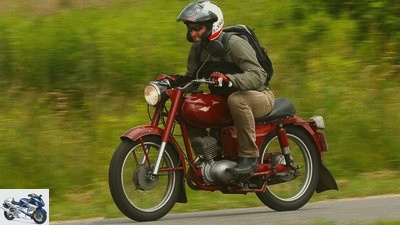
Bilski
At a kilometer reading of 24,500, we parted ways …
Let’s address the sore point right away: Yes, the WSK 125 is a disgraceful replica of the German universal talent DKW RT 125. To save my honor, however, it must be said that not only the Poles have done copy-and-paste. The Reich type 125 from the Auto Union motorcycle manufacturer DKW is considered the most copied motorcycle in the world.
Especially since after the Second World War the patent rights had expired and then almost everyone surfed the edge: The Soviets with the Komet K 125 or the class enemy Harley-Davidson with the Hummer. An illustrious society in which our sympathetic WSK 125 moves.
WSK itself is the third major motorcycle manufacturer in post-war Poland, alongside WFM (from Warsaw) and SHL (from Kielce). Founded in 1955 in Świdnik near Lublin, you should initially only work on WFM, but the WSKers quickly developed sporting ambitions and finally (until 1985 was shift again) also built competitive and quite successful off-road bikes.
Still questions, why my WSK would have easily mastered the Challenge Breslau – Stuttgart – IF IT WOULD NOT HAVE BEEN CUMPED BY A DISGUSTED GAUNER? In any case, the top priority on the air-cooled single-cylinder two-stroke engine from 1971 is: humility! Which is particularly expressed in terms of sitting posture – motto: your head between your knees. There was also a scrambler version, which today makes some hipster bobbers look pale around the beard.
Data
Type M06 B3, single-cylinder two-stroke engine, 123 cm³, 5.4 kW (7.3 HP) at 5300 rpm, three-speed gearbox, tubular / sheet metal press frame, front and rear tires 3.00-18, empty weight 98 kg, front and rear drum brakes, Ø 140 mm each, tank capacity 13 liters, top speed 80 km / h, construction period 1971 to 1974.
Pannonia 250
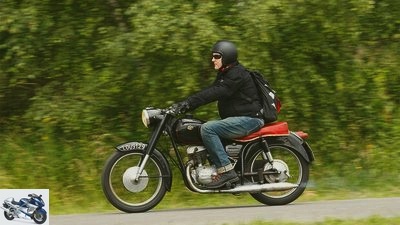
Bilski
120 km / h are quite realistic. So with a tailwind …
It all began on the Danube island of Csepel on the southern outskirts of Budapest. There the German-Jewish immigrant Manfred Weiss founded an iron foundry in 1880, which was to bear his name until the end of the Second World War and which became an industrial giant and leading arms manufacturer in Austria-Hungary at the beginning of the 20th century. Defense company and motorcycle factory – a very popular combination at the time: BSA, Husqvarna, Jawa, Simson and a few more did it that way.
From 1933 onwards, 98s and 125s were manufactured on the Csepel, which were initially called as their place of origin: Csepel. In 1949 the first 250 from the now nationalized band ran and was given the name Pannonia in 1954. There was no more space on Csepel for the production of the 125cc models, and so their production was relocated to the Danuvia weapons factory, where they continued to be built under the brand name Danuvia – the attentive reader already suspects it – until 1963.
In the meantime, the 250 series developed into an export hit, but the West didn’t notice much of it. Because the majority, at peak times over 30,000 units per year, went to the Soviet Union from the beginning of the 1960s. At the end of the 1960s, Pannonia tried a two-cylinder two-stroke engine that looked suspiciously like a Yamaha, but after only 7,500 copies of the poorly developed P20, that was all over again.
When the Soviets did not renew the treaties, it was finally over in 1975. In the west, Pannonia has always been a somewhat exotic brand, but a close circle (pannoniafreunde.de) appreciates the beefy and comfortable beauties. The TLF’s taillight alone …
Data
Type T1 / TLF, single-cylinder two-stroke engine, 247 cm³, 12 kW (16 HP) at 5250 / min, four-speed gearbox, double-loop tubular frame, front tires 3.00-19, rear 3.25-19, empty weight 146 kg, drum brake front and rear, Ø 180 mm each, tank capacity 18 liters, top speed 115 km / h, construction period 1958 to 1964.
Jawa 350
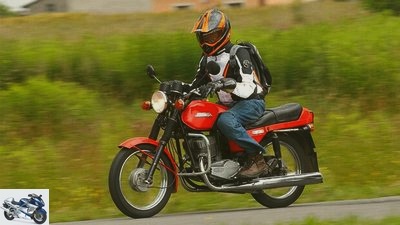
Bilski
In any case, the red indicator light, which announced the defect in the alternator, worked perfectly…
The history of the Jawa company is exciting: in 1929 the arms manufacturer František Janeček acquired the license to produce a motorcycle with a displacement of 500 cubic centimeters from the Chemnitz Wanderer-Werke AG. The first syllables of the names Janeček and Wanderer became Jawa.
In the beginning, components and engineering services were bought from outside companies, but then Jawa successfully developed motorcycles itself. While smaller cubic capacities were left to the sister brand ČZ, the 350 was made fit for the mass market. And the systems on my 638 model are really good. Two-cylinder two-stroke engine, full torque even at a low 1500 rpm! Robust construction, high payload, closed chain case, undemanding technology and plenty of space on the comfortable bench.
Thousands of times the machine, which has been built in various generations for 60 years, does its work in the vast countries of the East. It is considered a Czech tractor, its 26 hp is enough for almost 130 km / h. The 17-liter tank enables a decent range, and the on-board network is fed by a 12-volt battery. Handy is enough, at least if the steering head bearing is intact.
The material quality? Not so bad for a product from former communist countries. Good ergonomics even for tall drivers, but apparently weaknesses in the clutch, alternator, various bearings and the paint. If František Janeček had built his weapons in a similarly rustic style, we would be closer to world peace! Nevertheless: If the Lima hadn’t given up, the Jawa would have come to Stuttgart, I bet?
Data
Type 638 TS, two-cylinder two-stroke in-line engine, 344 cm³, 19 kW (26 HP) at 5250 rpm, four-speed gearbox, double-loop tubular frame, front tires 3.25-18, rear 3.50-18, empty weight 156 kg, drum brakes front and rear, Ø 160 mm each, tank capacity 17 liters, top speed 128 km / h, construction period 1984 to 1986.
Jorg Lohse: Of course, the WSK would have carried me to victory. What a question. After all, the cart is still running. And the one sitting on it will soon also be running. But with legs in hand. Just watch out, boy, we’ll get you! Herder, the old fox, has made it the furthest. Respect, colleague. Even if it was found in the parc ferme that the Pannonia was unlawfully equipped with wide tires! Bibi, on the other hand, disappointed me badly: Neither his Jawa nor his hair really worked in Polska.
Klaus Herder: In the end, only victory counts. Congratulations, beautiful Pannonia! And that you didn’t quite make it to Stuttgart, actually not even to the Czech border, is only due to my overcautiousness. Hours of city traffic in the sweltering heat caused the old lady to jam roughly 50 kilometers behind Breslau. Let it cool down, the engine runs again – but for another 700 kilometers the risk seemed too high to me. I also had to console the losers who were starving in the air-conditioned van. After all, you’re a colleague!
Markus Biebricher: Yes, I was unlucky. The problems with the Jawa were maddening! What you should refrain from in the stage of beginning baldness. There were no effective hair restorers in Poland either, but as a consolation I am not in such a bad position compared to my colleagues in terms of hair or driving technique. Lohse lost the chain because he had to scare the old lady at the Daimler at puberty, Herder overwhelmed his piston. I am now calling for revenge!
Info
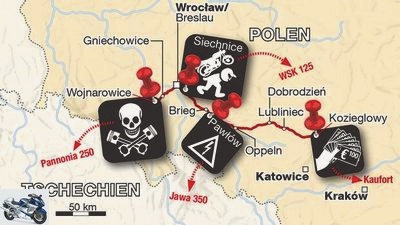
MOTORCYCLE
Travel time: 2 days Distance: 280, but felt 1000 kilometers
Poland is also worth a trip with modern motorcycles. Those who do not want to have their teeth, hair and bones fixed cheaply or buy scrap metal can simply enjoy the country and its people.
General: The south of Poland, like the rest of the country, is extremely varied: the most modern highways and metropolises, capitalism insignia such as huge billboards and shopping centers contrast with small villages where time has stood still. Yes, we have even seen donkey carts that my colleague Lohse’s WSK 125 would have (or would have liked?) To load..
The pretty ladies on the market square in Wroclaw were also helpful: By inviting them to cozy quarters, they tried to ensure the well-being of the strangers. It was only with great effort that we were able to ward off her motherly care.
By the way, Poland is a true paradise for birds. Storks and birds of prey everywhere, some great nature. Poland’s theft rate has leveled out at a good European average. The Polish language sounds difficult, but many young Poles speak English well.
Getting there: Via Dresden and Gorlitz to Breslau. Or via Prague to Jelenia Góra or to Kłodtzko. Alternatively via Brno to Bielsko Biała and Katowice.
Traffic: Contrasts here too. From donkey carts to 250,000-euro Bentleys, everything is on the move, with the number of newer cars now exceeding that of grilled cucumbers. The traffic behavior is similar to the German one – with a tendency towards more tolerance towards underpowered or drunk road users. Still, police officers seem rather strict.
Stay: Every larger town offers acceptable hotels. In Breslau we were impressed by the “Hotel Centrum Dikul”, Antoniego Cieszyńskiego 17-19, 50-136 Wrocław, phone 00 48/7 17 96-77 66 (www.dikul.pl), Single rooms from approx. 65 euros. Recommended for those looking for peace and quiet is the rustic one in the bosom of nature “Hotel Gosziniec Eden”: ul.Wczasowa 47, 58-350 Mieroszów. Telephone 00 48/7 48 42 18 34 (www.goscinieceden.pl). Single room approx. 21 euros.
Money: One euro is equivalent to 4.11 zlotys (PLN). With Poland joining the EU in 2004, the euro could be introduced in the near future. After initial enthusiasm, Poland is now taking its time and does not expect a currency change until 2017. Especially during the crisis, the PLN was able to cushion the loss of purchasing power through the sale of domestic products. That is why the euro did not convince the Poles in an opinion poll in 2011, 60 percent voted against it. By the way: the exchange offices in the country offer the best exchange rates. You can withdraw money from ATMs anywhere with an EC card.
Prices: When it comes to food, Poland is cheap, especially in rural areas: 0.5 liters of beer 1.25 euros. Buying a used motorcycle or car is rarely worthwhile. For less than 1000 euros, you can almost only get older motorcycles from former communist countries, which like to ask for a knowledgeable screwdriver. There are hardly any really cheap Japanese. Well restored machines (e.g. Junak) are just as expensive as ours. However, the supply of spare parts for old Eastern cucumbers in Poland is much better.
More tips: Cures, surgeries, or other medical services can actually turn out to be bargains. In addition: Poles are known for their craftsmanship. Extremely attractive for motorcycling in the south: the Giant Mountains and the High Tatras. Krakow is known as the secret capital with hip clubs and pubs as well as great cultural offerings. Last, not least, a book tip: “Motorcycles of the East” by Frank Ronicke, Motorbuch Verlag, two volumes, 9.95 euros each.
Related articles
-
Gargolov Sports & scene Life: Annual Review 2013 Annual review That was 2013 BMW celebrated its 90th anniversary, MOTORRAD turned 110! But there was also…
-
Lorenz to travel Poland and the Baltic States Poland and the Baltic States Stars in the east Estonia, Latvia and Lithuania: Completely different in…
-
BMW motorcycles Scene: BMW GS Challenge Scene: BMW GS Challenge Where planing takes place … Paddling, climbing, crossing, trialing, screwing,…
-
Jahn 33 pictures Jahn 1/33 Rolf Henniges and Stefan Kaschel: They have the same hairdresser, but not the same opinion. Jahn 2/33 Rolf Henniges was able…
-
Life: The motorcycle builder Umberto Borile
Gori Sports & scene Life: The motorcycle builder Umberto Borile The motorcycle manufacturer Umberto Borile Small escapes He’s causing a sensation with…
-
Life: Out and about in Mecklenburg-Western Pomerania
Daams to travel Life: Out and about in Mecklenburg-Western Pomerania Out and about in Mecklenburg-Western Pomerania Where the soul dangles The largest…
-
Motorcycle tour in Kashubia, Poland
Henniges 30th pictures Henniges 1/30 Low pressure areas can really spoil a tour. Five days of vacation, but not a sunspot! Apart from the Gdansk region….
-
Foitzik to travel Scene: Burt Munro Challenge Scene: Burt Munro Challenge Isle of Man, just the other way around At the southernmost end of New Zealand,…
-
markus-jahn.com to travel XXL Challenge 2017 XXL-Challenge 2017 – they are dreadful The beautiful in the supposedly ugly Seeing the beautiful in the…
-
On the go: Biker Festival and Bazaar in Poland
Bilski to travel On the go: Biker Festival and Bazaar in Poland Out and about in Poland Biker Festival and Bazaar in Poland Poland is not in the east,…